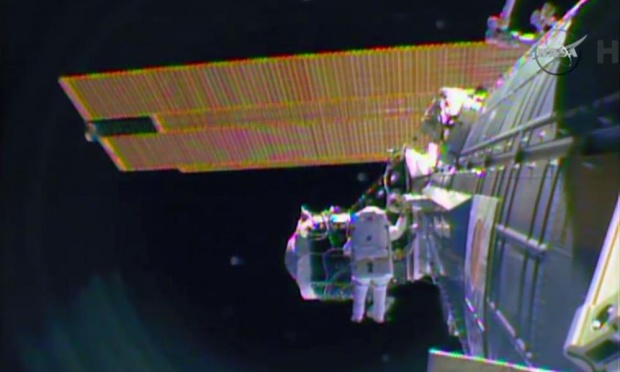
Astronauts Barry “Butch” Wilmore and Terry Virts—two members of the six-strong Expedition 42 crew currently aboard the International Space Station (ISS)—spent six hours and 41 minutes outside the orbital outpost today (Saturday, 21 February), laying and configuring cables in readiness for the arrival of two International Docking Adapters (IDAs), later this year. With Wilmore designated “EV1,” bearing red stripes on the legs of his Extravehicular Mobility Unit (EMU), and Virts as “EV2,” in a pure white suit, the two men stepped smartly through the tasks of U.S. EVA-29 and set to work on a number of get-ahead tasks for EVA-30. However, rising carbon dioxide levels in Virts’ suit led to a prudent decision to bring EVA-29 to a close after all of its objectives and more were accomplished.
As described in AmericaSpace’s EVA-29 preview article, this spacewalk had already been pushed back from the late January timeframe by delays in launching SpaceX’s CRS-5 Dragon cargo mission and was postponed by 24 hours from Friday, 20 February, due to the need for “added analysis” of the two EMUs. According to ISS Operations and Integration Manager Kenny Todd, speaking at the Johnson Space Center (JSC) in Houston, Texas, last week, the latter surrounded a “Non-Standard” element of open work on the EMUs.
He explained that during a routine coolant loop scrub activity on one of the suits late last year, the Fan Pump Separator (FPS)—which was also part of the root cause of the water-intrusion incident that forced the premature and highly publicized termination of EVA-23 in July 2013—failed to spin-up properly. Troubleshooting identified a possible mechanical binding issue in the FPS, and the installation of a new separator has produced no anomalies to date. Unfortunately, last month, the same issue arose in an FPS on another suit. Since it forms part of a single integrated unit, it is inaccessible to the ISS crew, but both faulty units were returned to Earth last week aboard the CRS-5 Dragon and initial evaluation points to a binding issue and areas of corrosion. Water chemistry tests suggest that each time the FPS is powered-up, more water is introduced to the system, and Mr. Todd stressed that his team is looking at improved sampling techniques to avoid damaging the FPS in the future. He concluded that both suits were running in fine shape and the corrosion issue is not expected to present a concern for the satisfactory operation of the fan pump separator. However, at the Mission Management Team (MMT) meeting on Thursday, 19 February, it was considered prudent to postpone EVA-29 until additional analysis had been completed.
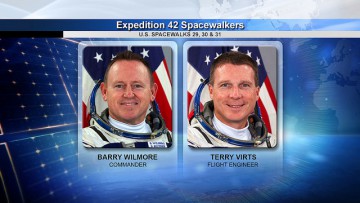
This particular spacewalk is of great importance to the future of the ISS. Its tasks were labeled “IDA Prep” in NASA’s most recent Flight Planning Integration Panel (FPIP) documents, and form part of the critical “IDA Pathway,” which was expected to see Wilmore and Virts laying cables and utilities for the two new docking adapters. These are expected to be delivered to the station aboard SpaceX’s CRS-7 and CRS-9 Dragon missions in June and December 2015 respectively. As outlined in an earlier AmericaSpace article, two Pressurized Mating Adapters (PMAs-2 and 3) will be outfitted with the IDAs, thereby converting them from the shuttle-era Androgynous Peripheral Attach System (APAS)-95 docking interface into the new Soft Impact Mating and Attenuation Concept (SIMAC), for use by Boeing’s CST-100 and SpaceX’s Dragon V-2 vehicles.
PMA-2 currently resides at the forward port of the Harmony node—the extreme “front end” of the ISS—and will be fitted with IDA-1. Meanwhile, PMA-3 is presently situated at the forward port of the Tranquility node, but will be robotically transferred to Harmony’s space-facing (or “zenith”) port in the October 2015 timeframe, in order to accept IDA-2 in December. However, in addition to the need for two ports for Commercial Crew vehicles, two ports are also needed for unpiloted visiting craft, including SpaceX Dragons, Orbital Sciences’ Cygnus, and Japan’s H-II Transfer Vehicles (HTV). In order to open up a second set of ports, this requires the movement of the 22-foot-long (6.7-meter) Leonardo Permanent Multipurpose Module (PMM) in late July from its current position at the Earth-facing (or “nadir”) port of the Unity node to the forward port of the Tranquility node. This will “open up” a new Common Berthing Mechanism (CBM) at Unity nadir to join the existing interface at Harmony nadir for unpiloted visiting vehicles, as well as ensuring that sufficient clearance is available for the arrival of future craft.
Final preparations got underway early Saturday morning, when Wilmore and Virts were assisted into the Quest airlock by their Expedition 42 crewmates Anton Shkaplerov of Russia and Italy’s first woman in space, Samantha Cristoforetti. Following a slight delay, they conducted 60 minutes of “pre-breathing” on masks, during which time the inner “equipment lock” of the airlock was depressed from its ambient 14.7 psi down to 10.2 psi. Upon completion of this protocol, Wilmore and Virts donned and purged their bulky EMUs and the airlock’s atmosphere was repressurized to 14.7 psi. This permitted them to enter a nominal pre-breathing regime, lasting 50 minutes, followed by another 50 minutes of In-Suit Light Exercise (ISLE). The latter was first trialed on the STS-134 shuttle mission in May 2011 and involved the spacewalkers flexing their knees for about four minutes, resting for 60 seconds, then repeating until the 50 minutes are up. This technique serves to rapidly remove nitrogen from their bloodstreams, thereby preventing a potentially fatal attack of the “bends.”
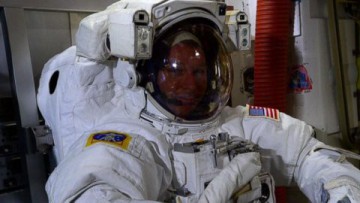
At length, the fully-suited pair and their equipment—including the Simplified Aid for EVA Rescue (SAFER) units, affixed to the lower section of their life-sustaining backpacks—were transferred by Cristoforetti from the equipment lock into Quest’s outer “crew lock.” Another delay was created by an issue with the primary data path on Virts’ suit, which necessitated additional time for communications checks. At length, the hatches between the two locks were closed and depressurization got underway. When it reached 5 psi, the process came to a halt for standard leak checks, after which depressurization continued until the crew lock reached a condition of near-vacuum. The EVA officially began when Wilmore and Virts transferred their suits’ critical life-support utilities over to internal battery power. EVA-29 kicked off at 7:45 a.m. EST, with Wilmore pushing open Quest’s outer hatch and departing the airlock, followed by Virts.
Wilmore brought out an IDA Port Cable Bag and Crew Lock Bag, and Virts will carry an identical set of bags for the starboard side. When both men were outside, they closed the thermal cover of Quest and pressed immediately into critical “buddy checks” to ensure that their suits and safety tethers were properly configured, as well as carrying out an inventory of their tools. Wilmore translated along the Crew and Equipment Translation Aid (CETA) Spur toward the port-zenith side of the U.S. Destiny laboratory, and eventually reaching the forward end cone of Harmony. Meanwhile, Virts followed a slightly different path, heading around the External Stowage Platform (ESP)-2 on the port side of Quest, and joined Wilmore at the front end of Harmony.
Despite some initial difficulties for Virts, the duo successfully stowed their bags and installed wire-tie restraints along routes where the cables were to be laid. Wilmore installed eight of the ties, and Virts completed a total of 11. Wilmore moved the existing PMA-2 umbilical cabling out of the way, preparatory to the removal of two Micrometeoroid Orbital Debris (MMOD) shields. Using a Pistol Grip Tool (PGT), they released three bolts holding the port-side shield in place and removed it. Virts then opened the Port IDA Cable Bag, and Wilmore disconnected four existing cables—previously used during shuttle dockings and still employed to provide PMA-2 heater power—from beneath the shield and Virts passed him the four new IDA cables to install. They reattached the MMOD shield, then moved to the starboard side of Harmony’s forward end cone, where they exchanged roles and Virts led the disconnection of existing cables and the installation of IDA cables.
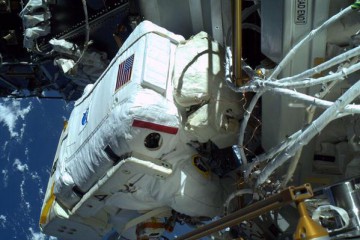
Before leaving the starboard cable bag, Wilmore retrieved the Purple Cable—the longest cable, in fact, at about 43 feet (13 meters) in length—and brought it to the port side of Harmony, where he attached it to Handrail 343 and uncoiled it along a “path” toward Destiny, in order to make a pair of connections. After some difficulty, he stowed one “leg,” which will eventually lead to PMA-3 after its relocation, and then secured the second leg with wire ties to await the arrival of IDA-1. Elsewhere, Virts unpacked and routed cables from the Port IDA Cable Bag to restore power and telemetry for the PMA-2 heaters, each of which carries “legs” destined for the forward end of the adapter, on zenith and nadir faces. Wilmore handled the port nadir route, and Virts the starboard zenith route.
By 5.5 hours into EVA-29, it seemed likely that the spacewalk would be extended to seven full hours, in order to complete all remaining cable work at the forward end of Harmony, thereby pressing into the early tasks originally earmarked for the upcoming EVA-30. Under this plan, Virts would work his way steadily aft, toward the forward end cone of the Destiny laboratory, where he was to set some inhibits in place in order to avoid any “hot” mates or demates of cables during the remainder of the IDA Prep work. Part of the setting of these inhibits required him to unplug four connectors to remove power, but after some difficulty an increase in carbon dioxide levels in his suit was noted. Told to settle down, Virts pressed on, but the issue with his suit remained and prompted Flight Director Tony Ceccacci to decide to call it a day. All of the EVA-29 tasks had been completed, and a fair portion of get-ahead work has been laid in readiness for next Wednesday’s EVA-30.
The success of today’s spacewalk was not lost on the NASA and international astronauts, assigned and unassigned, who undoubtedly watched, enviously, from the ground. “Working w/cable on a spacewalk … a very challenging/exhausting task,” exulted Astronaut Candidate (ASCAN) Anne McClain. “These guys laid 340 feet of cables in six hours 41 minutes. Wow!” Fellow astronaut Ricky Arnold—who performed two EVAs on shuttle mission STS-119 in March 2009—welcomed Virts to the spacewalking fraternity, whilst British astronaut Tim Peake noted that “laying cables is tough work on the hands.” Nicole Stott, who was selected as an astronaut in the same class as Wilmore and Virts, back in July 2000, paid homage to their class nickname: “Awesome work … Go Bugs!” Other former astronauts and veteran spacewalkers, including Mike Lopez-Alegria and Clay Anderson, also chimed in via Twitter, expressing their fervent wish to have taken part in today’s EVA. In response to Anderson’s light-hearted plea, Canada’s most experienced spacewalker, Dave Williams, tweeted: “If you ever need an EV2, give me a call. I’ll be your wingman, anytime!”
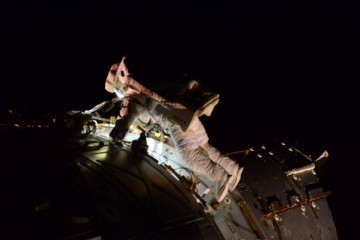
Returning inside the Quest airlock and closing the hatch, EVA-29 ended at 2:26 p.m. EST, after six hours and 41 minutes. Today’s excursion marked the 185th spacewalk dedicated to ISS construction and maintenance, since the inaugural EVA by STS-88 astronauts Jerry Ross and Jim Newman to install cables and utilities between the U.S. Unity node and the Russian-built Zarya functional control block on 7 December 1998. Since then, spacewalkers have toiled in the near-total vacuum outside the station to create the grandest engineering accomplishment in history. In total, they have spent 1,159 hours and eight minutes in pressurized suits, working in the harshest environment known to humanity.
This was Wilmore’s second EVA—following his inaugural career excursion in October 2014—and he had previously accrued about six hours and 34 minutes of spacewalking time, whilst Virts had not previously ventured outside his spacecraft in orbit. With today’s six-hour and 41-minute EVA-29, Wilmore has now accumulated 13 hours and 15 minutes of spacewalking time, which moves him from 166th place to 116th on the list of 211 spacewalkers from the United States, Russia, France, Germany, Japan, Switzerland, Canada, Sweden, China, and Italy, since Alexei Leonov’s pioneering excursion, way back in March 1965. Having completed his first career EVA, Virts now sits in 164th place on the list.
Want to keep up-to-date with all things space? Be sure to “Like” AmericaSpace on Facebook and follow us on Twitter: @AmericaSpace




2 Comments
2 Pings & Trackbacks
Pingback:1st of three spacewalks completed | Off to the Space Races
Pingback:Weekly Links